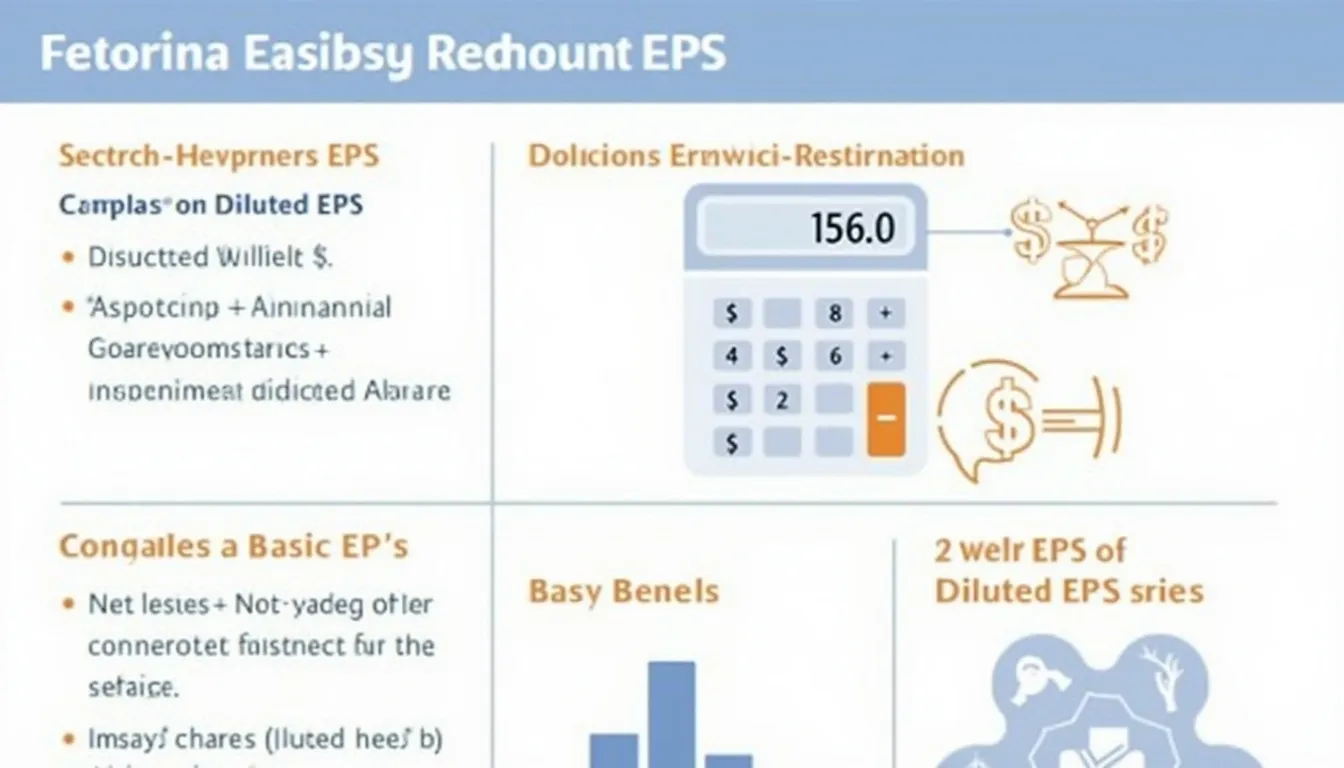Diluted Earnings per Share Calculator
Is this tool helpful?
Diluted Earnings per Share Calculator: Maximize Your Financial Analysis
How to Use the Diluted EPS Calculator Effectively
Our Diluted Earnings per Share (EPS) Calculator is a powerful tool designed to help investors, financial analysts, and business professionals accurately assess a company’s profitability on a per-share basis. To use this calculator effectively, follow these simple steps:
- Enter the company’s Net Income in the first input field.
- Input the Average Shares outstanding in the second field.
- Provide the number of Other Convertible Instruments in the third field.
- Click the “Calculate” button to generate the Diluted EPS result.
The calculator will instantly compute the Diluted EPS, displaying the result with two decimal places for precision. This user-friendly interface allows for quick calculations and easy comparisons between different companies or time periods.
Understanding Diluted Earnings per Share: Definition, Purpose, and Benefits
Diluted Earnings per Share (Diluted EPS) is a crucial financial metric that provides a more conservative and comprehensive view of a company’s profitability compared to basic EPS. It’s calculated using the following formula:
$$\text{Diluted EPS} = \frac{\text{Net Income}}{\text{Average Shares} + \text{Other Convertible Instruments}}$$
The purpose of Diluted EPS is to show the potential impact on earnings per share if all dilutive securities (such as convertible preferred shares, convertible debentures, stock options, and warrants) were to be exercised. This metric is essential for investors and analysts as it provides a “worst-case scenario” perspective on a company’s earnings power.
Key benefits of using Diluted EPS include:
- More accurate representation of a company’s earnings potential
- Better comparability between companies with different capital structures
- Enhanced insight into the potential dilution of existing shareholders’ ownership
- Improved decision-making for investors and financial professionals
The Advantages of Using Our Diluted EPS Calculator
Our Diluted EPS Calculator offers several advantages that make it an indispensable tool for financial analysis:
- Time-saving: Quickly compute Diluted EPS without manual calculations or complex spreadsheets.
- Accuracy: Minimize human error and ensure precise results every time.
- User-friendly interface: Intuitive design makes it easy for users of all skill levels to calculate Diluted EPS.
- Instant results: Get immediate feedback on how changes in input values affect the Diluted EPS.
- Accessibility: Access the calculator from any device with an internet connection.
- Educational tool: Learn about the components of Diluted EPS and their impact on financial analysis.
Addressing User Needs and Solving Specific Problems
Our Diluted EPS Calculator addresses several key user needs and solves specific problems in financial analysis:
1. Comprehensive Earnings Assessment
By incorporating both average shares outstanding and other convertible instruments, the calculator provides a more thorough evaluation of a company’s earnings potential. This comprehensive approach helps users make more informed investment decisions.
2. Simplified Comparative Analysis
The calculator enables quick and easy comparisons between different companies or time periods. Users can swiftly input various scenarios to assess how changes in net income, average shares, or convertible instruments affect Diluted EPS.
3. Risk Assessment
By considering the potential dilution from convertible securities, the calculator helps users evaluate the risk of earnings dilution for existing shareholders. This insight is crucial for both investors and company management in assessing the impact of financial decisions.
4. Valuation Support
Diluted EPS is a key input in many valuation models, such as the price-to-earnings (P/E) ratio. Our calculator streamlines the process of obtaining accurate Diluted EPS figures, enhancing the reliability of these valuation models.
5. Financial Reporting Assistance
For professionals involved in financial reporting, our calculator serves as a quick verification tool to double-check Diluted EPS calculations before publication in financial statements or reports.
Practical Applications and Use Cases
To illustrate the practical applications of our Diluted EPS Calculator, consider the following use cases:
1. Investment Analysis
An investor is comparing two technology companies, TechCo A and TechCo B, to determine which offers better value. Using our calculator, they input the following data:
TechCo A:
Net Income: $100 million
Average Shares: 50 million
Other Convertible Instruments: 5 million
Calculated Diluted EPS: $1.82
TechCo B:
Net Income: $80 million
Average Shares: 40 million
Other Convertible Instruments: 2 million
Calculated Diluted EPS: $1.90
Despite TechCo B having lower net income, its Diluted EPS is higher, potentially indicating better value for investors.
2. Financial Planning
A CFO is considering issuing convertible bonds to raise capital. They use the calculator to assess the potential impact on Diluted EPS:
Current Scenario:
Net Income: $50 million
Average Shares: 20 million
Other Convertible Instruments: 1 million
Calculated Diluted EPS: $2.38
After Issuing Convertible Bonds:
Net Income: $50 million
Average Shares: 20 million
Other Convertible Instruments: 3 million
Calculated Diluted EPS: $2.17
This analysis helps the CFO understand the potential dilution effect and make an informed decision about the bond issuance.
3. Earnings Forecasting
An analyst is projecting future earnings for a company and wants to estimate Diluted EPS under different growth scenarios:
Base Case:
Net Income: $200 million
Average Shares: 100 million
Other Convertible Instruments: 10 million
Calculated Diluted EPS: $1.82
High Growth Scenario:
Net Income: $250 million
Average Shares: 100 million
Other Convertible Instruments: 10 million
Calculated Diluted EPS: $2.27
Low Growth Scenario:
Net Income: $180 million
Average Shares: 100 million
Other Convertible Instruments: 10 million
Calculated Diluted EPS: $1.64
These calculations allow the analyst to provide a range of potential Diluted EPS figures in their report.
Frequently Asked Questions (FAQ)
1. What is the difference between Basic EPS and Diluted EPS?
Basic EPS only considers the current outstanding shares, while Diluted EPS accounts for all potential dilutive securities that could be converted into common shares. Diluted EPS provides a more conservative estimate of earnings per share.
2. Why is Diluted EPS important for investors?
Diluted EPS gives investors a more accurate picture of a company’s earnings power by considering the potential dilution from convertible securities. This helps in making more informed investment decisions and comparing companies with different capital structures.
3. How often should I calculate Diluted EPS?
Diluted EPS is typically calculated and reported quarterly and annually in financial statements. However, investors and analysts may calculate it more frequently when evaluating a company’s performance or making investment decisions.
4. Can Diluted EPS be higher than Basic EPS?
In most cases, Diluted EPS is lower than or equal to Basic EPS. However, in rare situations where convertible securities are anti-dilutive (their conversion would increase EPS), Diluted EPS can be higher than Basic EPS.
5. What types of securities are considered in the “Other Convertible Instruments” category?
Other Convertible Instruments typically include convertible preferred shares, convertible bonds, stock options, warrants, and any other securities that can be converted into common shares.
6. How accurate is this Diluted EPS Calculator?
While our calculator is designed to provide accurate results based on the input provided, it’s important to note that we can’t guarantee that the webtool or results from our webtool are always correct, complete, or reliable. Our content and tools might have mistakes, biases, or inconsistencies. Users should always verify results with other sources and consult financial professionals for important decisions.
Conclusion: Empowering Your Financial Analysis with the Diluted EPS Calculator
Our Diluted Earnings per Share Calculator is an invaluable tool for anyone involved in financial analysis, investment decision-making, or corporate finance. By providing quick, accurate calculations of Diluted EPS, it empowers users to:
- Make more informed investment decisions
- Conduct comprehensive company valuations
- Assess the potential impact of dilutive securities
- Compare companies with different capital structures
- Streamline financial reporting and analysis processes
The user-friendly interface, coupled with the calculator’s ability to handle complex scenarios, makes it an essential resource for both novice investors and seasoned financial professionals. By incorporating this tool into your financial analysis toolkit, you’ll enhance your ability to assess company performance, evaluate investment opportunities, and make data-driven decisions.
Take advantage of our Diluted EPS Calculator today and elevate your financial analysis to new heights. Whether you’re an investor looking to optimize your portfolio, an analyst preparing comprehensive reports, or a finance professional seeking to streamline your workflow, this tool is designed to meet your needs and exceed your expectations.
Start using our Diluted EPS Calculator now and experience the difference it can make in your financial decision-making process!
Important Disclaimer
The calculations, results, and content provided by our tools are not guaranteed to be accurate, complete, or reliable. Users are responsible for verifying and interpreting the results. Our content and tools may contain errors, biases, or inconsistencies. We reserve the right to save inputs and outputs from our tools for the purposes of error debugging, bias identification, and performance improvement. External companies providing AI models used in our tools may also save and process data in accordance with their own policies. By using our tools, you consent to this data collection and processing. We reserve the right to limit the usage of our tools based on current usability factors. By using our tools, you acknowledge that you have read, understood, and agreed to this disclaimer. You accept the inherent risks and limitations associated with the use of our tools and services.







